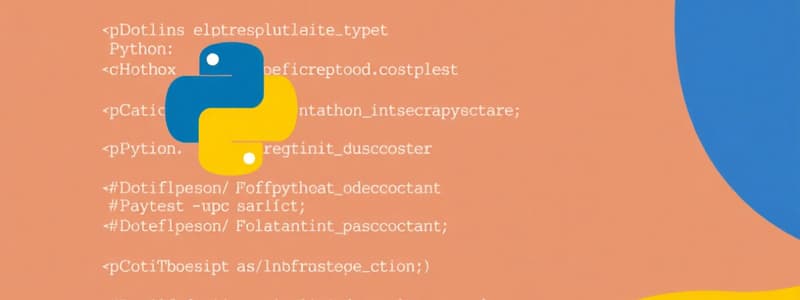Podcast
Questions and Answers
What data type is used to represent whole numbers in Python?
What data type is used to represent whole numbers in Python?
- str
- bool
- int (correct)
- float
Which of the following data types in Python is mutable?
Which of the following data types in Python is mutable?
- dict (correct)
- set (correct)
- list (correct)
- tuple
What symbol is used for assignment in Python?
What symbol is used for assignment in Python?
- = (correct)
- @
- ->
- :
What does the None type represent in Python?
What does the None type represent in Python?
Which operator is used for exponentiation in Python?
Which operator is used for exponentiation in Python?
Flashcards
Booleans (bool)
Booleans (bool)
Represents truth values, either True or False. Used for making decisions in code.
Lists (list)
Lists (list)
Ordered collections of items that can be changed after they are created. They are written within square brackets.
Tuples (tuple)
Tuples (tuple)
Ordered collections of items that cannot be changed after they are created.
Sets (set)
Sets (set)
Signup and view all the flashcards
None
None
Signup and view all the flashcards
Study Notes
Introduction to Python Syntax
- Python is a high-level, interpreted, general-purpose programming language.
- Its syntax emphasizes readability, using indentation to define code blocks instead of curly braces or keywords like
beginandend. - This structure makes Python code more maintainable and easier to understand.
Basic Data Types
- Integers (int): Whole numbers, positive or negative, without decimal points. Examples:
10,-5,0 - Floating-point numbers (float): Numbers with decimal points. Examples:
3.14,-2.5,0.0 - Strings (str): Sequences of characters enclosed in single quotes (
'...') or double quotes ("..."). Examples:"Hello",'World' - Booleans (bool): Represents truth values, either
TrueorFalse. - Lists (list): Ordered, mutable collections of items. Examples:
[1, 2, 3],['apple', 'banana'] - Tuples (tuple): Ordered, immutable collections of items. Examples:
(1, 2, 3),('red', 'green') - Dictionaries (dict): Unordered collections of key-value pairs. Examples:
{'name': 'Alice', 'age': 30} - Sets (set): Unordered collections of unique items. Examples:
{1, 2, 3},{'a', 'b'} - None: Special constant representing the absence of a value. Python uses it to denote the lack of a specific value for a particular variable or in a function's return statement.
Variables and Assignment
- Variables are used to store data.
- Assignment is done using the
=operator. - No explicit declaration of data type is required; Python infers the type based on the assigned value.
Operators
- Arithmetic operators:
+,-,*,/,//(integer division),%(modulo),**(exponent). - Comparison operators:
==,!=,>,<,>=,<=.
Control Structures
- Conditional statements (if-elif-else): Used to execute code conditionally.
- Looping statements (for and while): Repeated execution of code blocks.
forloops iterate over sequences,whileloops execute as long as a condition is true.
Functions
- Defining functions: Use the
defkeyword to define a function, specifying the name, input parameters (arguments), and a code block to be executed. - Function calls: Invoke a function by using its name followed by parentheses containing the arguments.
- Return values: Functions can return values using the
returnstatement.
Modules and Packages
- Modules: Reusable blocks of code. Python provides many built-in modules (e.g.,
math,os) and you can create your own. - Packages: Groups of related modules.
Input/Output
- Input: Input from the user is taken using the
input()function. If you need to parse strings to integers or floats, you need to apply Type Casting, usingint()orfloat(). - Output: Output to the console is done using the
print()function or other functions for file writing.
Comments
- Single-line comments start with the
#symbol. - Multiline strings can be used as documentation or multiline comments.
String Manipulation
- Strings are sequences of characters and have methods for manipulation:
len()returns the length of a stringupper(),lower()to change case.split()to divide a string into a list of substringsjoin()to combine elements of a list into a stringreplace()to substitute substrings in a string
Exception Handling
try-exceptblocks are used to handle potential errors (exceptions) during program execution. Allows robust code that can recover from errors in a controlled manner.
Studying That Suits You
Use AI to generate personalized quizzes and flashcards to suit your learning preferences.




